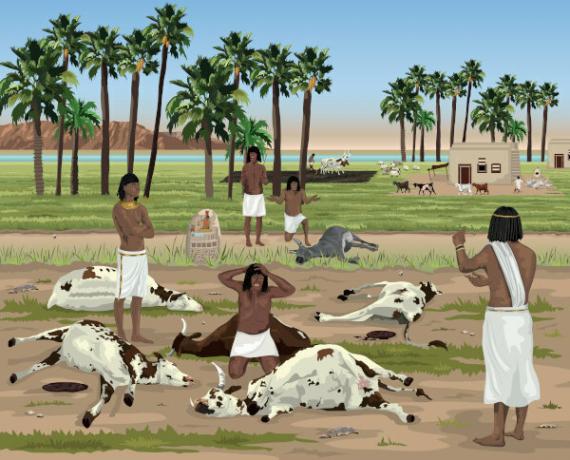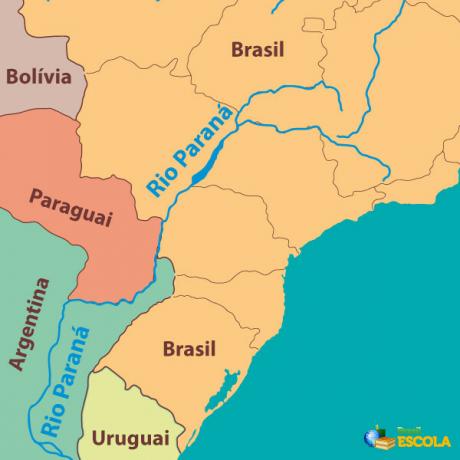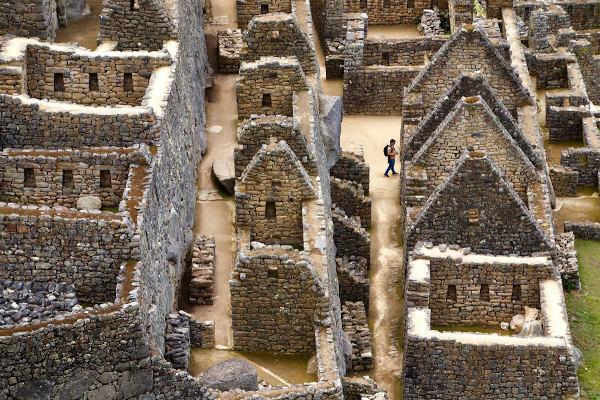To the ten plagues of egypt are a biblical narrative that tells the story of ten plagues that would have been sent by God to Egypt as a form of punishment, because Pharaoh Ramses II refused to give freedom for the Hebrews. At the end of the tenth plague, Pharaoh allowed the Israelites to leave Egypt, taking everything they owned with them.
Historians consider that the story of the ten plagues of Egypt is not real and is therefore a myth. However, many researchers look for evidence that the plagues happened, and one theory points out that they may be related to the consequences of a volcanic eruption that happened in Greece, but affected the Egypt.
Read too: Passover - feast celebrating the end of slavery in Egypt
Topics of this article
- 1 - Summary of the ten plagues of Egypt
- 2 - The ten plagues of Egypt in the biblical narrative
- 3 - What were the ten plagues of Egypt?
- 4 - Consequences of the ten plagues of Egypt
- 5 - What is the meaning of the ten plagues of Egypt?
- 6 - Did the ten plagues of Egypt really happen?
Summary of the ten plagues of Egypt
The ten plagues of Egypt is a biblical narrative that tells of the sending of ten plagues to Egypt.
These plagues would have been sent by God as punishment because Ramses II would not free the Israelites from slavery.
The plagues were diverse, including: frogs, flies, locusts, diseases, darkness, infanticide.
Only after the tenth plague — the death of the firstborn — did Pharaoh authorize the Israelites to go.
Historians consider this narrative to be, in fact, a myth.
The Ten Plagues of Egypt in Biblical Narrative
The Ten Plagues of Egypt is a biblical narrative that tells the story of plagues that would have been sent by God as a form of punishment to the Egyptians. They were sent because Pharaoh Ramses II refused to grant freedom to the Israelites. The spokesman for God's will in this scenario was Moses, who was a Hebrew but had been raised by Egyptians.
The narrative of the plagues of Egypt takes place in a context in which the Israelites they wereenslaved in egypt and God intervened in the situation by choosing Moses to guide these people to freedom. The promise to the Israelites was that they would be delivered and led to the land that God had chosen for them.
However, Pharaoh Ramses II refused to release them, and God then intervened by punishing Egypt with ten plagues.. The narrative tells that, in each plague, the pharaoh agreed to release the Israelites, but returned to his decision as soon as the punishment ended. This scenario was repeated until the tenth plague, when Pharaoh finally agreed to release the Israelites.
Do not stop now... There's more after the publicity ;)
What were the ten plagues of Egypt?
According to the biblical narrative, the ten plagues of Egypt were as follows:
Water turned into blood:to the waters of the river Nile they were converted to blood and all the animals that lived in them died.
Frog infestation: the land of Egypt was covered with a great infestation of frogs.
Head lice infestation: A massive infestation of lice hit Egypt, affecting both the Egyptian population and the animals.
Swarm of flies: a great swarm of flies reached Egypt to such an extent that the sky was covered. Flies infested only the places of the Egyptians.
Plague on animals: the fifth plague uniquely affected all the livestock of the Egyptians, causing them to be stricken with disease and die.
Wounds over the whole body: all the Egyptians were afflicted with great sores on the skin, and, again, this plague only broke out among them.
hail rain: the seventh plague was marked by a strong storm, with lots of lightning and hail, which caused great destruction, affecting crops and killing the Egyptians who were not protected.
Grasshopper Infestation: locust infestation that destroyed the remainder of the Egyptian crops that had not been destroyed during the hailstorm.
Three days of darkness: Egypt was covered by three days of darkness so deep that it was not possible for people to see each other.
Death of the firstborn: in the last and hardest of the plagues, God authorized the angel of death to pass through the land of Egypt and kill all the firstborn, between humans and animals, who lived there. Only the firstborn of those who had put lamb's blood on the doorposts were spared, as Moses had instructed the Israelites. In this plague the son of Pharaoh Ramses II also died.
See too: What were the gods of Ancient Egypt?
Consequences of the Ten Plagues of Egypt
After the ten plagues, Pharaoh agreed to release the Israelites, authorizing them to take everything they owned. The Israelites then began their trek to Canaan., regarded by them as the land promised by God.
What is the meaning of the ten plagues of Egypt?
The biblical plagues in Egypt are also interpreted, within the Christian perspective and the Hebrew view, as a way for the Hebrew God to humiliate the Egyptian deities.
Know more: Egyptian Civilization in Antiquity
Did the ten plagues of Egypt really happen?
Historians treat the narrative of the plagues of Egypt as a myth, so they are not understood as a historical event. Still, many researchers have dedicated themselves to understanding this biblical narrative, and some theories have been raised to explain why it happens.

One of the theories says that a volcanic eruption on the island of Santorini, Greece, around 1600 BC. C., may have caused numerous impacts in Egypt, even at a considerable distance. This volcanic eruption would have released a large amount of ash and other toxic materials into the atmosphere.
Among the materials expelled by the volcano would be cinnabar, a mineral capable of transforming the waters of a river, such as the Nile, in red as blood. The accumulation of acidity in the waters would have made frogs abandon them and invade Egyptian residences. The animals and humans who died as a result of the effects of the eruption must have had their bodies used by mosquitoes as a storehouse for larvae. The larvae became adult flies and caused the swarm.
Furthermore, the eruption may have caused severe climate change in Egypt, allowing, for example, the formation of acid rain that would have caused injuries in humans. The acidity in the grass would have caused the death of animals that fed on it and the humidity would have attracted locusts, which attacked the crops.
Finally, the volcanic eruption would have been responsible for the darkness, as the amount of smoke would prevent sunlight from penetrating. This same theory also points to evidence that supports a high number of deaths of aristocrats, which can be related to biblical infanticide.
image credits
[1] Distant Shores Media/ Sweet Publishing/ Wikimedia Commons
By Daniel Neves
History teacher
Would you like to reference this text in a school or academic work? Look:
SILVA, Daniel Neves. "Ten Plagues of Egypt"; Brazil School. Available in: https://brasilescola.uol.com.br/historiag/dez-pragas-do-egito.htm. Accessed on April 20, 2023.
Visit to learn more about the gods of Egypt. Understand how the Egyptians saw their own gods. Meet the main Egyptian deities.
Click on the link to access this text and learn important details about the history of the Hebrews. See what history says about these ancient people.
Discover the life story of Jesus Christ. Understand who he was and what researchers say about this historical figure.
Learn how the belief in immortality influenced the Egyptian people in the development of mummification techniques and the construction of grandiose tombs.
Access and learn about the Jewish Passover, a millennial celebration that recalls the liberation of the Hebrews from slavery in Egypt. Understand how Jews celebrate this date.
The main characteristics of religion in Ancient Egypt.
The hierarchy that organized individuals in Ancient Egypt.


